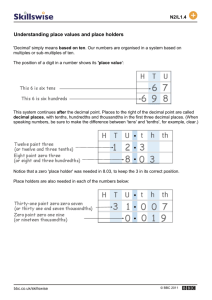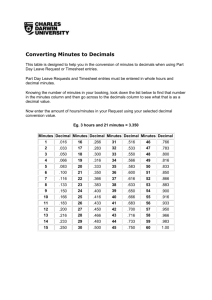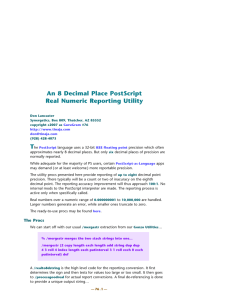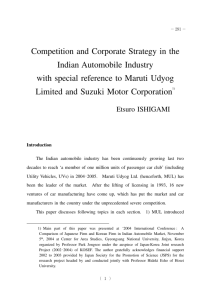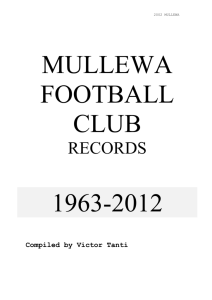Grade 5 Module 1
advertisement
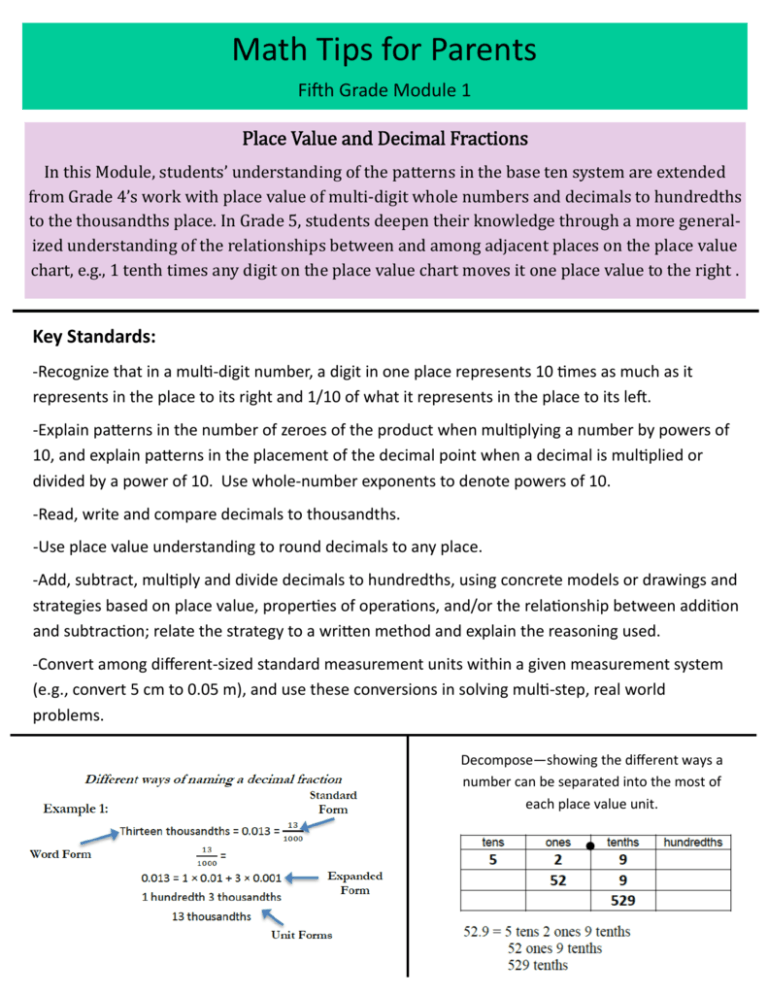
Math Tips for Parents Fi h Grade Module 1 PlaceValueandDecimalFractions InthisModule,students’understandingofthepatternsinthebasetensystemareextended fromGrade4’sworkwithplacevalueofmulti‐digitwholenumbersanddecimalstohundredths tothethousandthsplace.InGrade5,studentsdeepentheirknowledgethroughamoregeneral‐ izedunderstandingoftherelationshipsbetweenandamongadjacentplacesontheplacevalue chart,e.g.,1tenthtimesanydigitontheplacevaluechartmovesitoneplacevaluetotheright. Key Standards: ‐Recognize that in a mul ‐digit number, a digit in one place represents 10 mes as much as it represents in the place to its right and 1/10 of what it represents in the place to its le . ‐Explain pa erns in the number of zeroes of the product when mul plying a number by powers of 10, and explain pa erns in the placement of the decimal point when a decimal is mul plied or divided by a power of 10. Use whole‐number exponents to denote powers of 10. ‐Read, write and compare decimals to thousandths. ‐Use place value understanding to round decimals to any place. ‐Add, subtract, mul ply and divide decimals to hundredths, using concrete models or drawings and strategies based on place value, proper es of opera ons, and/or the rela onship between addi on and subtrac on; relate the strategy to a wri en method and explain the reasoning used. ‐Convert among different‐sized standard measurement units within a given measurement system (e.g., convert 5 cm to 0.05 m), and use these conversions in solving mul ‐step, real world problems. Decompose—showing the different ways a number can be separated into the most of each place value unit. Fi h Grade Module 1 Terms, Phrases and Strategies in this Module: Thousandths: one of 1,000 equal parts; thousandth’s place (in decimal nota on) the posi on of the third digit to the right of the decimal point Hundredths: one of 100 equal parts; hundredth’s place (in decimal nota on) the posi on of the second digit to the right of the decimal point Tenths: one of 10 equal parts; tenth’s place (in decimal nota on) the posi on of the first digit to the right of the decimal point Place Value: the value of the place of a digit (0‐9) in a number Decimal Frac on: a frac onal number with a denominator of 10 or a power of 10 (10, 100, 1,000). It can be wri en with a decimal point Exponent: tells the number of mes the base is mul plied by itself. Example: 104—the 4 is the exponent and tells us the 10 (base) is mul plied 4 mes (10x10x10x10) Equa on: statement that two mathema cal expressions have the same value, indicated by use of the symbol =; e.g., 12=4x2+4 Millimeter: a metric unit of length equal to one thousandth of a meter Standard Form: a number wri en in the format: 135 Expanded Form: e.g., 100+30+5=135 Unit Form: e.g., 3.21= 3 ones 2 tenths 1 hundredth Whenwemultiplyadecimalfractionbyapowerof10,theproductwillbe largerthantheoriginalnumber;thereforeweareshiftingtotheleftonthe placevaluechart.Thenumberoftimesweshifttotheleftdependsonthe powerof10.Ifmultiplyingby10,weshiftoneplacetotheleft.Ifmultiplying by100,weshifttwoplacestotheleftandifmultiplyingby1,000,weshift threeplacestotheleftandsoon. 3.452 x 10 = 34.52 A decimal number has two digits to the right of its decimal point. If we round it to the nearest tenth, the result is 13.7. What is the maximum possible value of this number? Include the mid‐ point on your number line. Whenwedivideadecimalfractionbyapowerof10,theproductwillbe smallerthantheoriginalnumber;thereforeweareshiftingtotheright ontheplacevaluechart.Thenumberoftimesweshifttotheright dependsonthepowerof10.Ifdividingby10,weshiftoneplacetothe right.Ifdividingby100,weshifttwoplacestotherightandifdividing by1,000,weshiftthreeplacestotherightandsoon.. 345 ÷ 100 = 3.45 Fi h Grade Module 1 3.64 + 1.47 = ______ How you can help at home…. Create number cubes or spinners and have the student iden fy the place value and value of different digits in that number. Roll or pick numbers to create decimals. Add, subtract, mul ply or divide the decimals. Find the ba ng averages or other sta s cs in the sports sec on of a newspaper and add or subtract the sta s cs. Es mate and find the sums and differences of items at the store and in restaurants. Prac ce basic addi on, subtrac on, mul plica on and division facts. Roll or pick numbers to create decimals. Compare and order the numbers. Choose a four‐digit number. Mul ply and divide by powers of 10, (10, 100, 1,000, etc.) by moving the decimal point le or right as appropriate.

